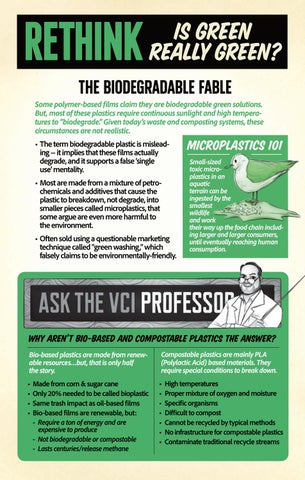RETHINK
IS GREEN REALLY GREEN?
THE BIODEGRADABLE FABLE Some polymer-based films claim they are biodegradable green solutions. But, most of these plastics require continuous sunlight and high temperatures to “biodegrade.” Given today’s waste and composting systems, these circumstances are not realistic. • The term biodegradable plastic is misleading -- it implies that these films actually degrade, and it supports a false ‘single use’ mentality. • Most are made from a mixture of petrochemicals and additives that cause the plastic to breakdown, not degrade, into smaller pieces called microplastics, that some argue are even more harmful to the environment. • Often sold using a questionable marketing technique called “green washing,” which falsely claims to be environmentally-friendly.
MICROPLASTICS 101 Small-sized toxic microplastics in an aquatic terrain can be ingested by the smallest wildlife and work their way up the food chain including larger and larger consumers, until eventually reaching human consumption.
WHY AREN’T BIO-BASED AND COMPOSTABLE PLASTICS THE ANSWER? Bio-based plastics are made from renewable resources...but, that is only half the story.
Compostable plastics are mainly PLA (Polylactic Acid) based materials. They require special conditions to break down.
• Made from corn & sugar cane • Only 20% needed to be called bioplastic • Same trash impact as oil-based films • Bio-based films are renewable, but: - Require a ton of energy and are expensive to produce - Not biodegradable or compostable - Lasts centuries/release methane
• High temperatures • Proper mixture of oxygen and moisture • Specific organisms • Difficult to compost • Cannot be recycled by typical methods • No infrastructure for compostable plastics • Contaminate traditional recycle streams




